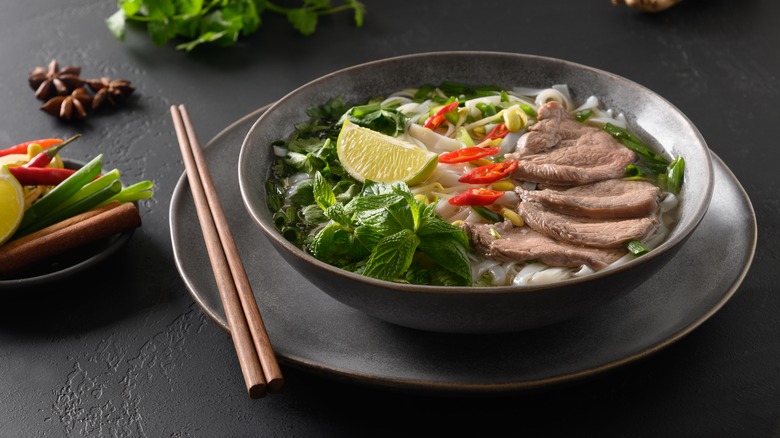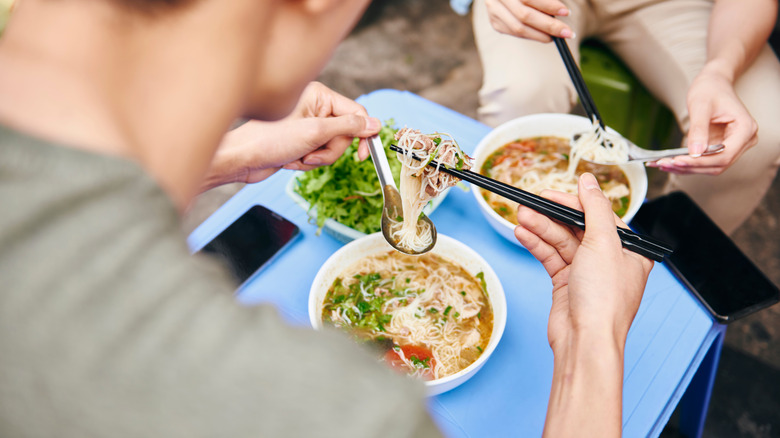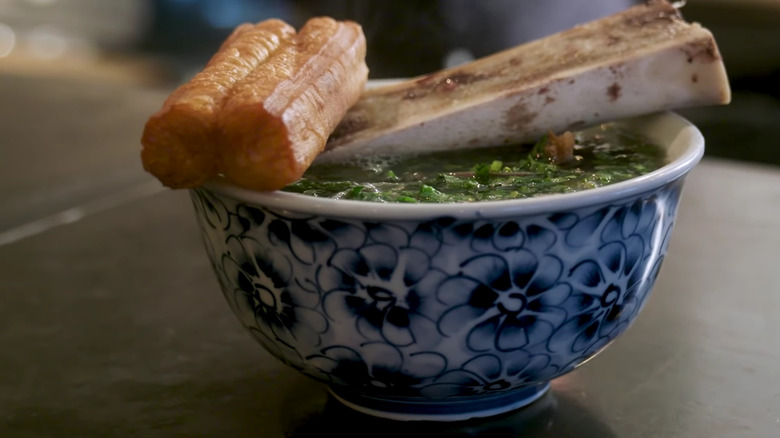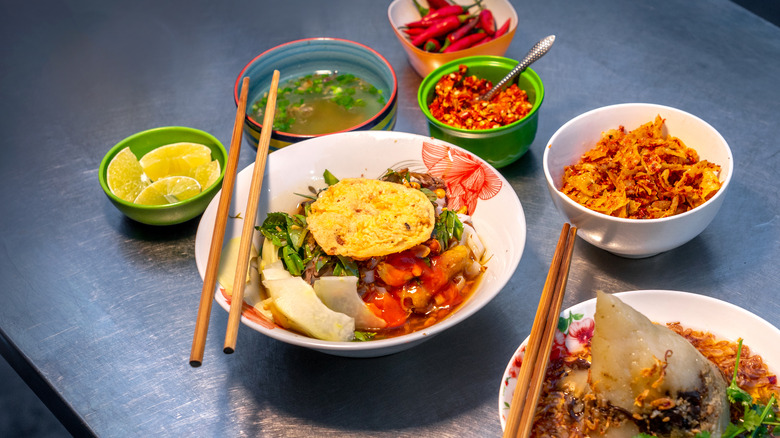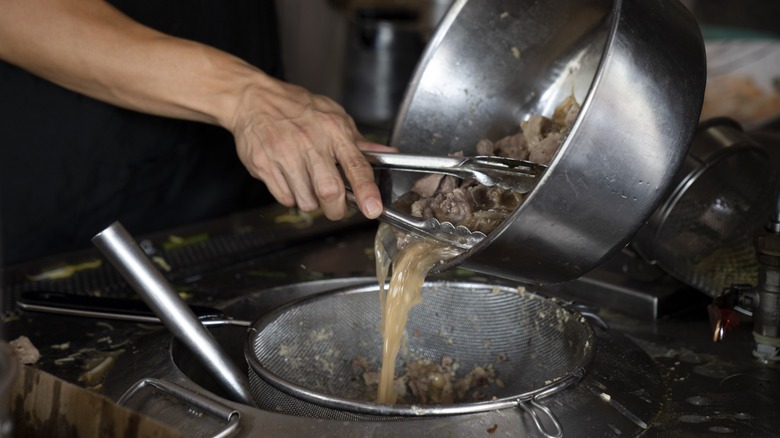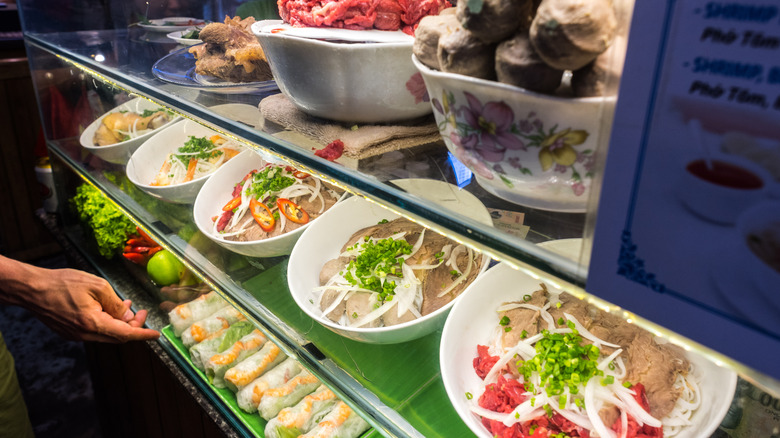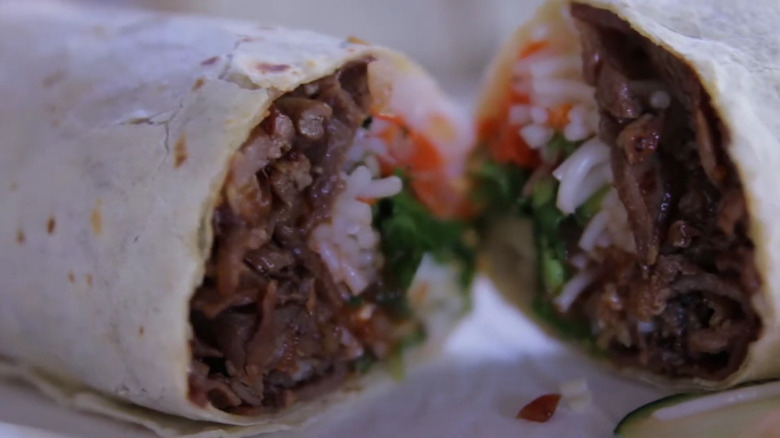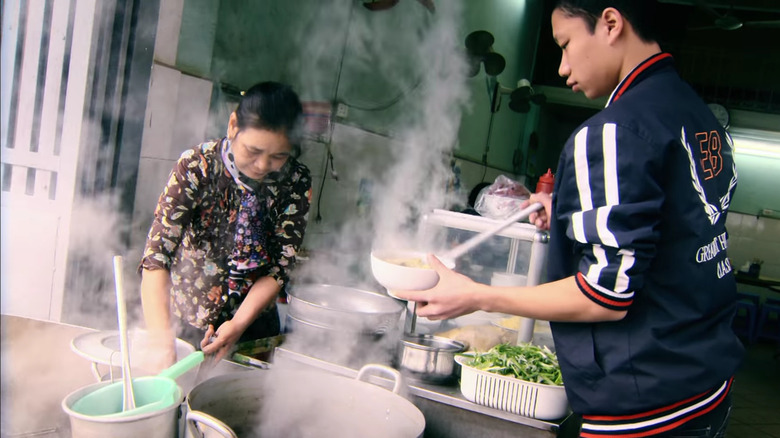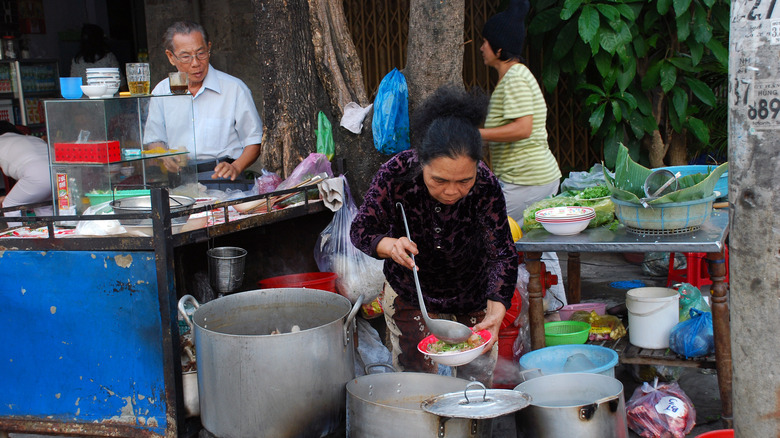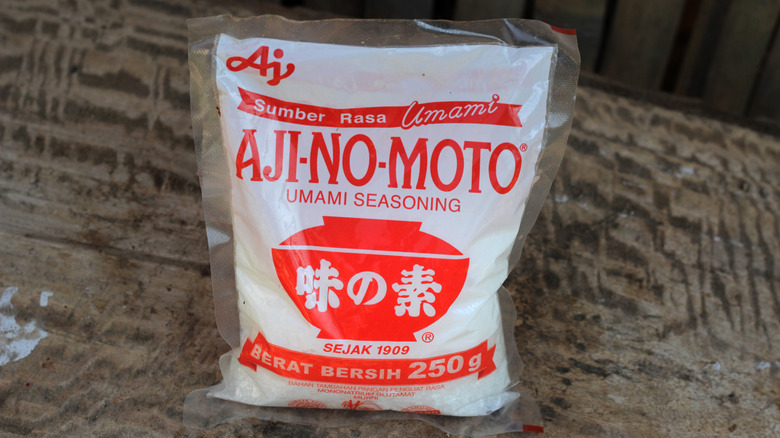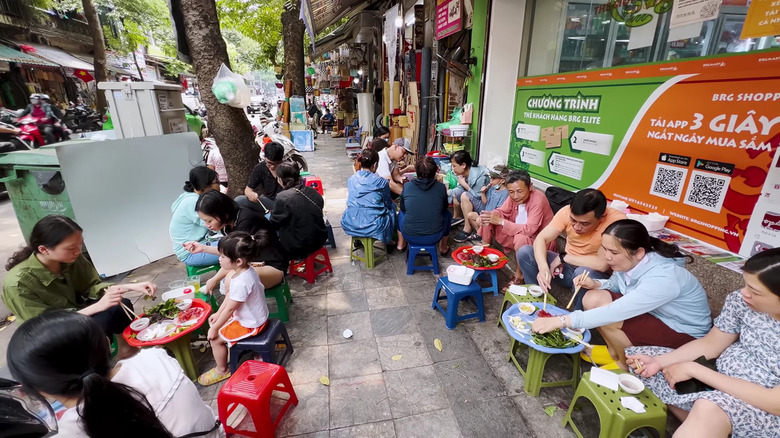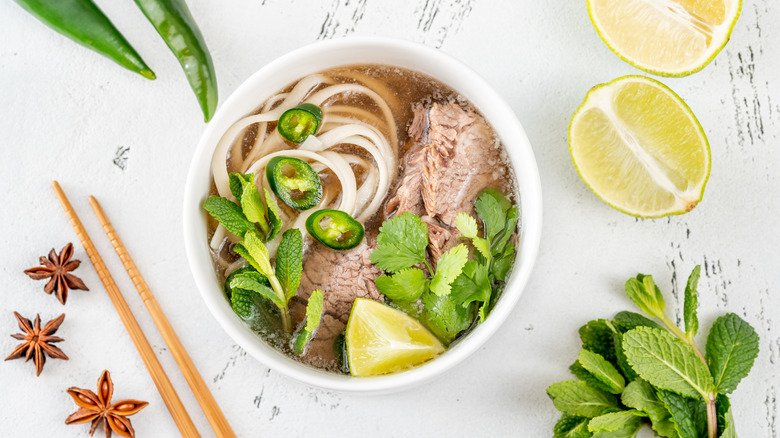The Ultimate Guide To Pho
As with many foods that have become global sensations, the nuances and history of pho can be poorly understood by many international consumers. Indeed, pho has formed the basis of multiple food reckonings. In the West alone, food publications such as Bon Appétit, and influencers like Tieghan Gerard have both been criticized for the mislabeling or misrepresentation of pho. Most commonly, this takes the form of presenting pho as "another noodle soup," or "the new ramen," a process that simultaneously trivializes both the dish and the history from which it was created (via NPR).
The truth is that pho is a dish steeped in flavor, history and locality. No two phos are the same, and the way in which a pho dish is assembled, which ingredients are used, and how it is garnished often changes from province to province, and frequently from chef to chef. These disparities are not random acts, but have arisen in response to events that have occurred throughout Vietnam's history, including the effects of French occupation and the Vietnam War.
Furthermore, as a highly adaptable dish, pho rewards thoughtful and respectful reinvention, and is constantly surprising both chefs and consumers alike. As Andrea Nguyen — a Vietnamese American chef and Asian cuisine expert — put it, pho is always changing (per BBC). Consequently, this guide does not claim to be 100% comprehensive. Rather, it aims to serve as an introduction to this storied dish, providing a foundation for further observations as you delve deeper into pho and the culture that created it.
Pho's exact origins are contested
Despite common misconceptions, pho is not an ancient dish. In fact, it was created fairly recently, emerging from the Nam Dinh province in northern Vietnam during the late 19th and early 20th centuries (per BBC). Both the location and timing of this emergence would suggest that French occupying forces — in what was then known as French Indochina — played a role, if not in pho's creation, then at least its popularization. Indeed, multiple facets of pho's cooking processes borrow techniques popular in French cuisine, including the roasting of bones and the creation of clear broths, according to Luke Nguyen, a Vietnamese Australian chef (via Mint).
Others, like those at Saigon Food Tour, point to the myriad of similar dishes prominent in Vietnamese cuisine before the creation of pho — most notably xáo trâu — as the dish's inspiration. These precursors to pho, and the dish itself, were undoubtedly influenced by Chinese communities that settled in northern Vietnam, through the introduction of ingredients like rice noodles. Pho is therefore an amalgamation of cultures, combined to create something unique and distinctly Vietnamese.
According to chef Peter Franklin, a chef born in Vietnam and raised in the United States, "pho is an iconic national dish and an original Vietnamese creation that combines local as well as foreign culinary influences. ... The Vietnamese took on inspiration with foreign ingredients such as beef, noodles, ginger and star anise; however, they were adept at customizing the dishes by adding nuoc mam (fish sauce) and fresh herbs and vegetables, the defining characteristics of the local cuisine" (via Jeannie Cho Lee).
Hanoi and Saigon pho differ greatly
As highlighted by chef Luke Nguyen in SBS, the two main categories of pho are northern style (Hanoi) and southern style (Saigon). The former style of pho — which comes from Vietnam's capital and the surrounding area — is largely defined by its simplicity. The broth is clear, garnishes remain minimal, and the use of sauces is generally light, according to Vietcetera. On the contrary, pho that comes from the southern part of the country — known as Saigon pho despite the city being renamed Ho Chi Minh City — is a study in extravagance. Saigon pho comes with an array of herbs and vegetables to add to the bowl, frequently including Thai basil and bean sprouts, whilst the broth is often cloudy, packing a more complex flavor due to the addition of other bones to the traditional beef broth, as reported by Vietnam Online.
Even the dining experiences are known to differ between the two halves of Vietnam's pho world. Andrea Nguyen, an expert in Vietnamese gastronomy, told The Takeout, "So the pho place we'd go to in Saigon? It's large, roomy, and clean. In Hanoi, it's smaller than a New York apartment — like a half-car garage."
In the aftermath of the Vietnam War, pho spread around the world
The Vietnam War saw the communist North Vietnam — which was supported by China and the Soviet Union — clashing with South Vietnam and the United States (per Britannica). The conflict lasted almost 20 years, ending in the communist government unifying the country two years after the fall of Saigon.
According to History, the Vietnam War caused the displacement of over three million refugees from Vietnam and its surrounding countries. Many of these refugees were resettled throughout Southeast Asia, as well as in North America and Europe, bringing their culture and cuisine with them. As many of those fleeing were from the defeated South Vietnam, the pho that was introduced to the wider world — and consequently went on to become a global phenomenon — was southern or Saigon style pho, rich in complex flavor and topped with a multitude of garnishes (via BBC).
There are many types of pho
The classic northern versus southern pho debate often obscures the fact that there are a large number of pho variants, each one spotlighting a different flavor, technique or ingredient. Pho bo, also known as beef pho, is one of the most popular northern types of pho. It can also lay claim to being the original form of pho, one that utilized the occupying French's favored ingredients of beef meat and bone-based broths (per Viet World Kitchen). Another traditional — albeit less globally popular — version of pho is pho chua, a sour take on the dish that originated in the northeastern province of Lang Sơn. As reported by Vietnam Online, pho chua includes both roast duck and pork, as well as a unique broth made with vinegar.
As reported by Taste Atlas, other variations include the highly popular pho ga (chicken), pho ca (fish) and stir-fried pho. It is important to note that every chef will create their own version of these distinct dishes, with each being able to be stylized in a northern or southern way through the absence or presence of garnishes and sauces, or through the altering of broth recipes.
A good broth is essential for all pho
The basis of a good pho is undoubtedly the broth. Whether clear or cloudy, it is this liquid that imparts the bulk of the dish's flavor. As such, every chef prioritizes their stock making process and swears by a few techniques to maximize its flavor. In an interview with The Splendid Table, Charles Phan — the chef behind famous Californian restaurant, The Slanted Door — revealed some of his favored techniques, which include blanching a variety of bones and roasting onions and ginger to add a depth of flavor to his pho bo, without compromising the broth's clarity.
The broth not only holds the flavor of pho, but also helps categorize it. As such, differences between northern and southern pho are no more exemplified than in the broths, as explained by Andrea Nguyen to The Takeout: "Northern Vietnamese food tends to favor the savory over sweetness. They also put emphasis on black cardamom, and it has this medicinal fragrance to it. In the South, they may use black cardamom in the broth, too, but they might tone it down with sweet spices such as cloves, cinnamon, star anise, and some rock sugar, too. In the North, they'd argue, 'We want a delicate broth.' In the South, it's 'We want it big and bodacious.'"
It is the national dish of Vietnam
Despite the many different variations of pho present throughout Vietnam, the dish is still seen as an important marker for collective Vietnamese identity. This is partly due to pho's status as Vietnam's national dish (per Food & Wine), a highly symbolic position which — as exemplified in the multidisciplinary journal Contemporary Levant – automatically lends a dish status, esteem and respect. However, pho didn't become popular as a result of being Vietnam's national dish. Rather, it has become Vietnam's national dish because it was such a powerful cultural identifier for a prolonged period of time.
On a metaphorical level, the dish is frequently viewed as a representation of the nation and a physical reconstruction of the cultures, events and circumstances that shaped the country itself (per Vietnam.com). In a literal sense, pho is a constant presence in many Vietnamese people's lives, with vendors and their specific versions of pho becoming a part of the local community's daily food rituals, as highlighted in The Guardian. For Vietnamese people living outside of Vietnam, pho is just as — if not even more — important, as it offers them a way to access their culture and its familiar, comforting flavors. As argued in Tu Thien's academic paper in the International Journal of Multilingualism, pho helps those in the diaspora to reconnect with their Vietnamese heritage and reinforce a sense of belonging.
Pho is always evolving
In stark contrast to many other national dishes, pho is constantly being tweaked, personalized, and adapted. These efforts — whether made by professional chefs or not — lead to new flavors, textures and experiences as pho adapts throughout time. While this is an often-celebrated aspect of the dish, pho's adaptability does mean that some chefs feel enabled to stretch the dish until it hardly resembles a traditional pho at all.
One such example comes via Chef Erwin Tjahyadi of Komodo in California who created the phorrito, a pho and burrito mash up that abandons pho's famous broth all together. Speaking to Los Angeles Magazine, Tjahyadi explained his surprise at how well the phorrito was received: "We all thought that this would generate a little bit of an outrage from the community and we would receive a lot of backlash. On the contrary, it's been very well received by our Vietnamese-American customers."
Another surprisingly successful, left-field spin on pho sees the dish transformed from food into drink. Uncle, a restaurant in Melbourne, Australia, has released the pho-groni, a cocktail based on the classic negroni, but using the flavors of Vietnam's national dish, as reported by Urban List.
Pho is traditionally a breakfast food
The difference between cultures and their cuisines is perhaps most readily demonstrated by how and what people eat for breakfast. In Vietnam, the traditional breakfast of choice is often pho. This is because pho was originally created as a breakfast that could fuel those who would spend their day physically exerting themselves in manual jobs throughout Vietnam's recent history, as explained by Tracey Lister, chef and director of the Hanoi Cooking Centre (via Eater). This might surprise those who did not grow up immersed in Vietnamese culture and subsequently view the dish as an evening meal.
Due to differing tastes and culinary norms, pho has been eaten throughout the day and evenings in most of the countries that it has been introduced to. Now, this more laissez-faire approach to pho consumption is becoming commonplace in Vietnam itself. There are a number of reasons for this, including the emergence of Vietnam's middle class and its demands (per Eater), as well as a generally more laidback consumer base. This more modern approach to the eating of pho is typified by Van Cong Tu — a Hanoi food blogger, expert and influencer — who told The Independent that consumers feel like there are no more rules surrounding pho, allowing them the freedom to order what they want, when they want.
Street vendors are an integral part of pho culture
It is true that there are numerous brick and mortar pho restaurants in Vietnam, from the bustling streets of Hanoi to the ancient alleyways of Hôi An. However, the lifeblood of pho — and Vietnamese cuisine in general — is undoubtedly street vendors. One 2015 figure from The Guardian suggests that around 11% of Ho Chi Minh City's workforce — something like 500,000 individuals — make their living in this manner.
This large number belies the extremely difficult conditions many vendors face. Historically, they've had to contend with the communist government's attempts to crack down on illegal capitalist trading, hence the portability of all traditional pho vendors' equipment, including the ubiquitous tiny plastic stools (via The Guardian). In contemporary Vietnam, the issues facing street vendors are many and varied, including erratically enforced street tidiness rules and the crippling effects of Covid-19 . Yet, many Vietnamese street vendors have prevailed, carving a life for themselves while also continuing their stewardship of a unique and emphatically popular dish.
Umami is the key to good pho
For a dish to receive the global acclaim that pho has, it needs to have a flavor profile with widespread appeal. With such variation in taste preferences between cuisines and cultures, this is no easy feat. However, one taste that seems to be widely adored is umami. Incidentally, pho just happens to be packed with this satiating, savory flavor, according to Saveur. Pho is rich in umami, predominantly due to the bone broth that acts as the foundation for most phos, although other additions such as sea worms and MSG can also be used to boost umami levels (per The Independent).
The latter is a controversial addition in most non-Asian kitchens, largely because of so-called "Chinese restaurant syndrome," a list of symptoms which were thought to be caused by ingesting MSG. However, studies have proven that MSG is indeed safe to eat, and that fears surrounding MSG's inclusion in food actually have origins in Western xenophobia and racism, according to a 2021 article in the Journal of the Academy of Nutrition and Dietetics. Yet, food habits are slow to change, and as reported by Food Insight, MSG use remains controversial in many Western countries, including the United States. This means that many American pho dishes may be lacking umami when compared with their Vietnamese prepared counterparts.
Relative prosperity and food security has made pho widely accessible again
The BBC and Eater highlight pho's origins as a cheap meal made to fuel hungry workers. Despite its egalitarian origins, though, the accessibility of pho has not always been guaranteed. Famine and food shortages plagued Vietnam in the latter half of the 20th century, due to a combination of war and failed agricultural reform. These shortages caused pho to become an expensive delicacy that many Vietnamese people were unable to access, a hardship still remembered by many Vietnamese people today, including Huong, a Vietnamese woman interviewed by The Guardian. She recalled her mother buying her a bowl of pho: "It must have cost her five dong. She was a teacher, so that would have been more than her daily wage. It was a delicious luxury, an extraordinary thing. You cannot understand how hungry we were."
Fortunately, Vietnam has experienced a dramatic upswing in quality of life over recent decades. As reported by The Borgen Project – a non-profit organization — healthcare and education services have improved, and poverty is on the decline. One happy by-product of all this is that in today's Vietnam, pho is once again a meal that can be enjoyed by the vast majority of the public.
Pho is hugely popular in the United States
Despite the ungrounded fears surrounding MSG consumption, pho has still managed to become incredibly popular within the United States. This trend started in the late 1990s and early 2000s after the United States' relationship with Vietnam stabilized and interest in the Southeast Asian country grew, a direct result of major political decisions such as the United States' lifting of a 30-year trade embargo, as highlighted in The International Lawyer.
In more recent years, pho's expansion throughout the United States has led new markets to be targeted, including the growing vegan and vegetarian consumer bases. JimmyTay Trinh and his sister, Jenny Hoang are the founders of Naughty Noah's, a brand that creates instant pho noodle pots that are suitable for vegans. Trinh explained the reasoning for creating a vegan version of a traditionally meat rich dish to New Hope Network: "Vegan is kind of the future in some ways. So we said, how can we take a traditional recipe that relies heavily on bone broth, modernize it to the American palate and make it sustainable. I wanted to put something there as a base foundation and leave it up to the consumer if they want to add other proteins or vegetables." Inventions such as these will surely only cement the dish further in the United States' culinary repertoire.
Pho is an extremely nutritious meal
Perhaps unsurprisingly for a meal that was created with fueling laborers in mind, pho has been proven to be extremely nutritious. As Jonathan Valdez, a registered dietician, told Parade, "In general, you will be getting a lot of iron, zinc, selenium, B-vitamins, fiber, magnesium, potassium, protein, vitamin C, vitamin K, vitamin E, vitamin A, antioxidants and carbs when you eat a bowl of pho with lean meats and vegetables."
Epicurious reported that this abundance of vitamins, minerals, and essential micro-nutrients is what has led pho to be a popular home remedy for any cold, flu or mild sickness for decades. However, not all pho is created equal, and as Livestrong points out, attention should be paid to the toppings, sauces and condiments that you add to your dish, as these may contain high levels of both salt and fat — nutrients that, if frequently consumed in excess, can cause health complications.
